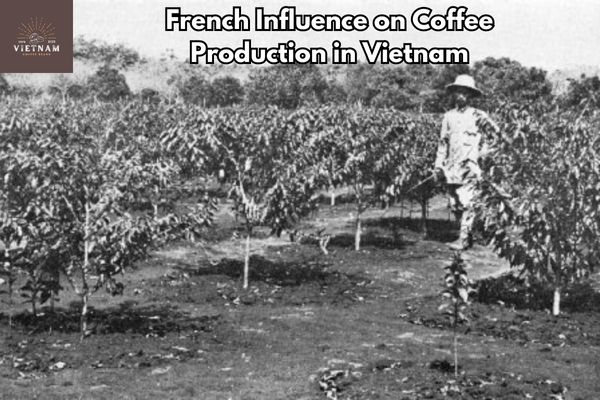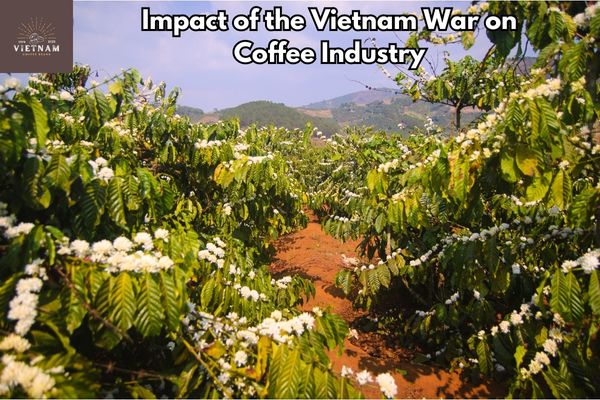As a coffee enthusiast, I have always been fascinated by the rich history and unique flavors of different coffee regions. One country that stands out in the world of coffee production is Vietnam.
With a history dating back to the late 19th century, when French missionaries introduced coffee plants, Vietnam has become the second largest producer of coffee in the world. This growth was fueled by the Đổi mới reforms in 1986, leading to the migration of coffee farmers to the Central Highlands.
However, this rapid expansion has come with social and environmental consequences, which I will explore in this article.
Key Takeaways
- Coffee production in Vietnam has a long history, starting with the introduction of coffee plants by French missionaries in 1857 and the establishment of the first coffee plantations in 1888.
- The industry has faced various challenges and fluctuations, including disruptions during the Vietnam War and low production due to collectivization after the war. However, the industry experienced growth after the Đổi mới reforms in 1986.
- Social inequality and environmental consequences are prevalent issues in the Vietnamese coffee industry. Indigenous peoples have been marginalized, and rapid deforestation and land encroachments have had severe environmental consequences.
- The coffee industry in Vietnam is influenced by global market dynamics and fair trade certifications. Fair trade certifications contribute to the country’s coffee export revenues, and the Vietnamese government plays a crucial role in shaping the fair-trade discourse. Vietnamese coffee competes in an international environment with different laws, cultures, tastes, and business practices.
History of Coffee Cultivation in Vietnam

In the history of coffee cultivation in Vietnam, the adoption of Tanzanian coffee cultivation methods played a pivotal role in revolutionizing the country’s coffee industry.
I learned that coffee cultivation in Vietnam began when French missionaries introduced coffee plants in 1857. Under French colonization, coffee production in Vietnam began to flourish. The first coffee plantations were established in 1888, with the Arabica variety initially dominating early coffee production.
In the 1920s, the French opened coffee production zones in the Central Highlands. However, the coffee industry faced disruptions during the Vietnam War and was collectivized after the war, resulting in low production. The industry experienced significant growth after the Đổi mới reforms in 1986.
Climate change has also had an impact on coffee production in Vietnam, with late rain causing losses in 2017. Despite these challenges, Vietnam is now the second largest producer of coffee in the world.
French Influence on Coffee Production

French missionaries introduced the coffee plant to Vietnam in 1857, sparking the development of the coffee industry. The French colonial legacy in Vietnam played a significant role in shaping the country’s coffee production.
Similarly, Costa Rica’s coffee industry overview can be traced back to the introduction of coffee in the country in the early 1800s. Coffee quickly became an important crop for the Costa Rican economy, and the country soon became a major exporter of coffee.
Today, Costa Rica is still a major producer of coffee, and the coffee industry is a major part of the country’s culture and economy.
French coffee varieties, such as Arabica and Robusta, were initially dominant in early coffee cultivation. The French also opened coffee production zones in the Central Highlands in the 1920s, further expanding the industry.
Today, Vietnam is the second largest producer of coffee in the world, and its coffee industry continues to thrive. The French influence can still be seen in the country’s coffee culture, with the use of all-metal single-cup filters called ‘phin’ and the tradition of serving coffee with sweetened condensed milk.
The French legacy in Vietnam’s coffee production is a testament to the enduring impact of colonialism on the country’s economy and culture.
The French influence on coffee production in Vietnam has created a unique blend of cultures, merging traditional Vietnamese techniques with a touch of French sophistication, while also drawing inspiration from the coffee industry in Colombia, offering a captivating and diverse coffee landscape in Vietnam.
Impact of the Vietnam War on Coffee Industry

The Vietnam War had a significant disruptive effect on the coffee industry, leading to a period of instability and low productivity. The war brought about various disruptions in the coffee industry, causing a decline in production and a lack of resources for coffee farmers.
As a result, the industry experienced a significant setback during this time. The impact of the war on the coffee industry can be seen in the table below:
| Impact of War on Coffee Industry |
|---|
| Decreased production |
| Shortage of resources |
| Disruption of supply chains |
| Decline in quality |
The war not only affected the production and quality of coffee, but it also disrupted the supply chains and caused a shortage of resources. This period of instability had a lasting impact on the industry, and it took time for the coffee industry to recover and regain its productivity after the war.
The coffee industry disruptions caused by the Vietnam War highlight the far-reaching consequences of war on various sectors of the economy.
The Vietnam War had a profound impact on the coffee industry, leading to significant disruptions and changes in global coffee markets, while the resilience and adaptability of coffee making in Puerto Rico served as a source of inspiration and innovation during this challenging time.
Đổi Mới Reforms and Coffee Industry Growth
After the Đổi Mới reforms in 1986, the coffee industry in Vietnam experienced significant growth and expansion. The government implemented policies that encouraged private enterprise and foreign investment, leading to a surge in coffee production and export growth.
Coffee production methods and technology advancements played a crucial role in this growth. Farmers adopted new techniques such as irrigation systems, mechanized harvesting, and improved processing methods. These advancements increased productivity and quality, making Vietnamese coffee competitive in the global market.
Additionally, the government focused on branding and promoting Vietnamese coffee, resulting in increased demand worldwide. Today, Vietnam is the second largest exporter of coffee in the world, contributing significantly to the country’s economy.
The Đổi Mới reforms revolutionized the coffee industry in Vietnam, transforming it into a major player in the global coffee market.
During the Đổi Mới reforms, Nicaragua’s role in global coffee production served as an inspiration for Vietnam, as it demonstrated how strategic policies and investments can lead to significant growth in the coffee industry.
Challenges and Fluctuations in Coffee Economy
During my research, I discovered that coffee farmers in Vietnam face cycles of boom and bust in their economy. This is due to various factors, including the effects of climate change on coffee production and the impact of the coffee industry on local communities.
- Effects of climate change on coffee production:
- Changing rainfall patterns and temperature fluctuations affect coffee yields and quality.
- Increased incidence of pests and diseases due to changing climatic conditions.
- Farmers have to adapt their farming practices to mitigate the impact of climate change.
- Impact of coffee industry on local communities:
- Coffee farming provides employment and income for many rural communities in Vietnam.
- The industry contributes to the development of infrastructure and services in coffee-growing regions.
- However, fluctuations in coffee prices can lead to financial instability for farmers and their communities.
These challenges highlight the need for sustainable practices and support for coffee farmers to ensure the long-term viability of the industry and the well-being of local communities.
As Vietnamese coffee economy faces various challenges and fluctuations, it can draw valuable lessons and insights from the rich history of coffee in Jamaica to navigate through uncertainties, optimize production, and tap into new markets with resilience and innovation.
Social Inequality in the Coffee Industry
As I delved deeper into the challenges and fluctuations of the coffee economy in Vietnam, I couldn’t ignore the glaring issue of social inequality within the coffee industry.
The reality is that social inequality and labor exploitation are deeply ingrained in the coffee production process.
Many coffee farmers in Vietnam, especially smallholders, bear the brunt of falling coffee prices. They often live in poverty and struggle to make ends meet. Additionally, the rapid growth of the industry has led to severe environmental consequences, such as deforestation and land encroachments, further exacerbating the social inequality.
Moreover, the coffee industry in Vietnam has been built at the expense of indigenous Montagnard peoples. The abolition of indigenous autonomous zones reflects Kinh chauvinism, perpetuating an ethnic inequality narrative.
It is essential to address these issues and work towards a more equitable and sustainable coffee industry that respects the rights and well-being of all those involved in production.
Social inequality in the coffee industry in Vietnam persists as a pressing issue, prompting researchers and activists to examine the root causes and potential solutions. Alongside this, they also study the challenges and innovations in Cuba’s coffee production, seeking valuable insights to address the systemic inequities and foster a more inclusive and sustainable coffee sector in Vietnam.
Environmental Consequences of Coffee Production
When examining the environmental consequences of the coffee industry in Vietnam, it becomes evident that rapid deforestation and land encroachments have had severe impacts on the natural resources and suitable lands in the country.
The consequences of deforestation include loss of biodiversity, soil erosion, and increased greenhouse gas emissions. Indigenous communities, who rely on the forests for their livelihoods, are disproportionately affected by these environmental changes. Their rights to the land and resources are often disregarded, leading to social inequality and marginalization.
It is crucial to address these issues and promote sustainable practices in the coffee industry to mitigate the deforestation consequences and protect the rights of indigenous peoples. By implementing responsible land management strategies and supporting indigenous communities, we can work towards a more environmentally and socially equitable coffee production in Vietnam.
Exploring the coffee industry in Ethiopia unveils valuable insights and lessons that can help address the environmental consequences of coffee production in Vietnam, as stakeholders strive to strike a balance between sustainable practices and meeting the demands of a growing industry.
Fair Trade Certification and Global Marketplace
I believe that fair trade certification plays a significant role in promoting ethical practices and ensuring the sustainability of the global coffee marketplace.
This certification serves as a powerful tool in addressing the social and environmental challenges that the coffee industry faces. By adhering to fair trade standards, coffee producers commit to fair wages, safe working conditions, and sustainable farming practices.
This certification effectively empowers farmers and workers, giving them access to better market opportunities and fairer prices for their products.
Moreover, fair trade certification raises consumer awareness about the importance of supporting ethical and sustainable coffee production. When consumers choose fair trade coffee, they actively contribute to creating a more equitable and environmentally responsible coffee industry.
Therefore, fair trade certification holds great potential in driving positive change within the global coffee marketplace.
Vietnamese Coffee Style and Culture
Brewed using all-metal single-cup filters called ‘phin’, Vietnamese coffee is known for its bold flavor and is often enjoyed with sweetened condensed milk to balance the taste.
This unique brewing method involves placing the coffee grounds in the phin, which is then set on top of a cup. Hot water is poured over the grounds, allowing the coffee to slowly drip through the filter. The result is a rich and aromatic cup of coffee that captures the essence of Vietnamese culture.
Coffee holds great cultural significance in Vietnam, where it is not just a beverage, but a symbol of hospitality and social bonding. It is a common sight to see locals gathering at coffee shops, enjoying a cup of coffee while engaging in lively conversations.
Coffee has become deeply ingrained in the daily lives of the Vietnamese people, reflecting their love for flavor and community.
International Competitiveness of Vietnamese Coffee
As a coffee lover, I am fascinated by the international competitiveness of Vietnamese coffee and how it has gained recognition in major consumer markets worldwide.
Vietnam is the second largest producer of coffee globally, and its coffee industry has experienced cycles of boom and bust due to global price fluctuations. Coffee farmers in Vietnam bear the brunt of falling prices, which can lead to hardships for their households.
In response to these challenges, fair trade coffee certification has emerged as a way to support Vietnamese coffee farmers and ensure they receive fair prices for their products. This certification scheme contributes to Vietnam’s coffee export revenues and projection in the global market.
However, fair trade coffee has also faced criticism for perpetuating the idea that consumers have the most significant role in alleviating poverty among farmers.
Despite these challenges, Vietnamese coffee continues to compete in an international environment, showcasing its unique style and culture through its brewing methods and use of condensed milk.
Frequently Asked Questions
Conclusion
In conclusion, as an experienced coffee enthusiast, I have learned that Vietnam’s coffee production has come a long way since its humble beginnings.
From the introduction of coffee plants by French missionaries to the challenges faced during the Vietnam War, the industry has persevered and thrived.
The Đổi mới reforms sparked a period of growth, making Vietnam the second largest coffee producer globally. However, this growth has not been without consequences, as the industry faces environmental issues and social concerns.
With fair trade certifications and the unique Vietnamese coffee style gaining popularity, Vietnam’s coffee industry continues to make its mark on the global marketplace.



